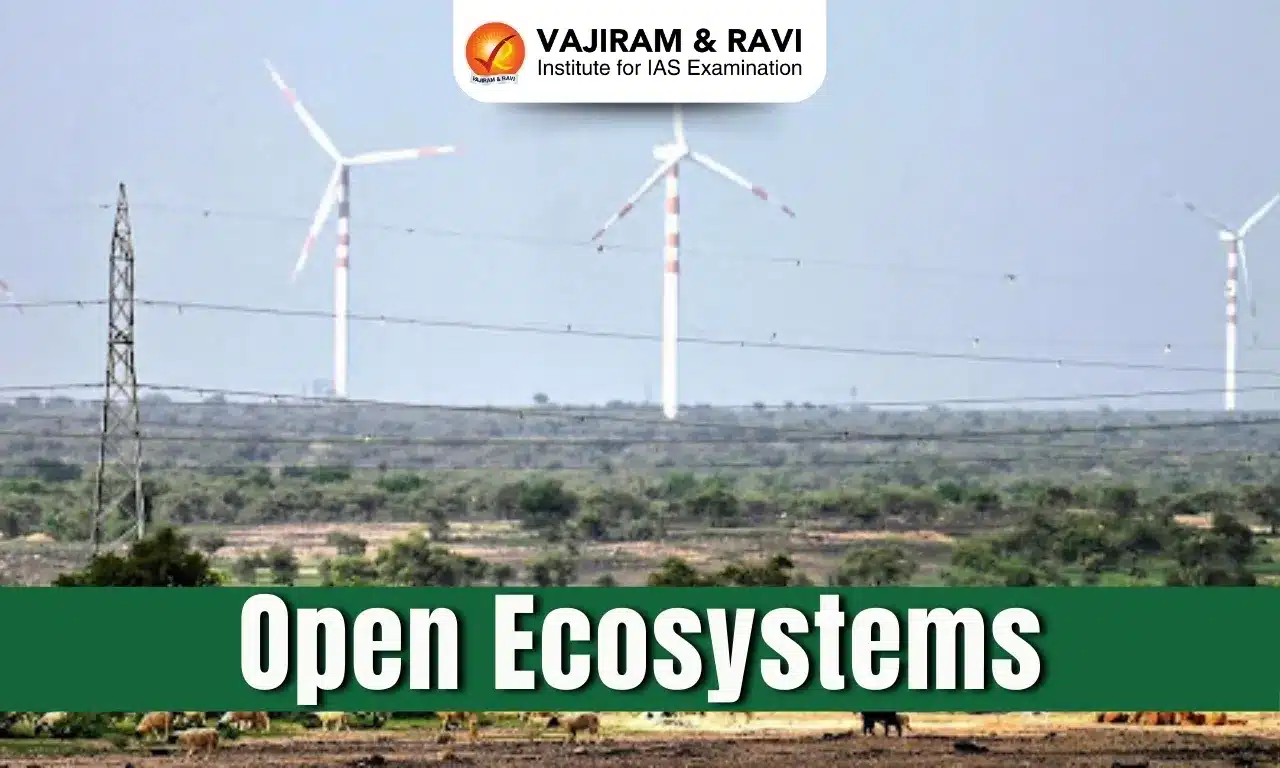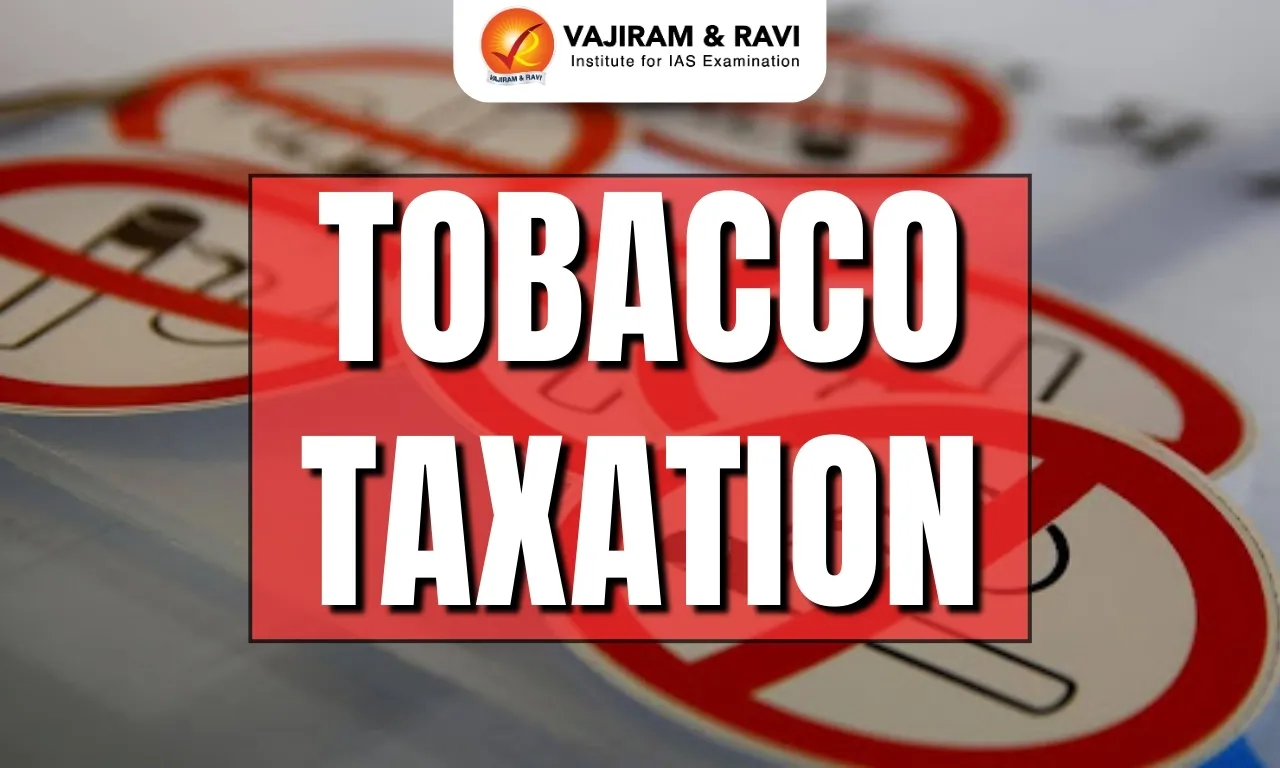Open Ecosystems Latest News
Experts and environmentalists have raised concerns over India’s continued misclassification of deserts, grasslands, and savannas as “wastelands,” urging policymakers to recognise the ecological and socio-cultural value of these open ecosystems to ensure their protection and sustainable management.
Introduction
- India’s deserts, grasslands, and savannas, collectively known as open ecosystems, are rich in biodiversity and cultural heritage.
- Yet, these landscapes continue to be misunderstood and misclassified as “wastelands,” often targeted for tree plantations or industrial use.
- Recent expert commentary emphasises the ecological importance of these open ecosystems and the urgent need to re-evaluate national land-use policies that ignore or erase them.
Understanding Open Ecosystems and Their Importance
- Open ecosystems such as arid deserts, grasslands, scrublands, and savannas are characterised by sparse tree cover and vast stretches of herbaceous or shrubby vegetation.
- Contrary to the common perception of being barren, these landscapes are finely tuned to their environmental extremes and support rich biodiversity.
- Notably, deserts occupy nearly one-third of Earth’s terrestrial surface and host uniquely adapted flora and fauna.
- Historical evidence also reveals that several ancient civilisations, including those in Mesopotamia, Egypt, and the Indus Valley, emerged in desert climates, underscoring the capacity of these ecosystems to support complex societies.
Misclassification and the Legacy of ‘Wastelands’
- India’s policy and administrative frameworks have long inherited colonial land-use classifications, wherein vast tracts of open natural ecosystems are marked as “wastelands.”
- This term erroneously implies that such lands are unproductive and in need of transformation, typically through afforestation, agricultural conversion, or urban development.
- Official government records have classified millions of hectares of grasslands, savannas, and scrublands as wastelands.
- This mischaracterisation has led to extensive ecological damage and a weakening of ecosystem services such as carbon sequestration, soil fertility, and water retention.
Ecological and Social Value of Open Landscapes
- India’s open ecosystems are home to several endangered and endemic species such as the Great Indian Bustard, caracal, Indian wolf, and the chinkara.
- These species rely on the unique structure and rhythm of open habitats to thrive.
- Additionally, while tree-based carbon storage receives most attention, grasslands and savannas store substantial carbon deep in the soil, making them important in combating climate change.
- Beyond biodiversity, these ecosystems are also vital to human livelihoods.
- Millions of pastoralist communities, including the Dhangars of Maharashtra, Rabaris of Gujarat, and Kurubas of Karnataka, depend on these landscapes for grazing. These groups have historically functioned as custodians of ecosystem health through practices like rotational grazing and water conservation.
- However, policies that promote fencing, tree planting, or repurposing of grasslands often result in displacement, loss of income, and erosion of traditional ecological knowledge among these communities.
Rethinking Land Restoration and Greening Goals
- The tendency to “green” deserts or grasslands through tree plantations often stems from the flawed belief that tree cover alone equates to ecological health.
- Such approaches may lead to monoculture plantations that degrade local biodiversity and disrupt seasonal ecological cycles.
- Experts advocate for a restoration model that is low-tech, community-driven, and grounded in ecological principles. Strategies include:
- Protecting native vegetation and enabling natural regeneration.
- Promoting soil and moisture conservation through water harvesting.
- Drawing from indigenous land management knowledge.
- Recognising carbon stored in soil as a climate mitigation metric.
- Importantly, policies must move away from one-size-fits-all afforestation efforts and instead embrace the diversity of India’s ecosystems.
Policy Recommendations and the Road Ahead
- To ensure a sustainable future, India needs a paradigm shift in how it understands and manages open ecosystems. Policy recommendations include:
- Revising land classification systems to eliminate the “wasteland” tag.
- Formulating ecosystem-specific conservation plans.
- Recognising the rights and stewardship roles of pastoralist communities.
- Integrating open ecosystems into national climate and biodiversity strategies.
- Incentivising the conservation of soil carbon alongside forest carbon.
- Experts also call for symbolic shifts, such as renaming the World Day to Combat Desertification and Drought to “World Day to Combat Land Degradation”, to acknowledge the ecological legitimacy of deserts and grasslands.
Source: TH
Last updated on January, 2026
→ Check out the latest UPSC Syllabus 2026 here.
→ Join Vajiram & Ravi’s Interview Guidance Programme for expert help to crack your final UPSC stage.
→ UPSC Mains Result 2025 is now out.
→ UPSC Notification 2026 is scheduled to be released on January 14, 2026.
→ UPSC Calendar 2026 is released on 15th May, 2025.
→ UPSC Prelims 2026 will be conducted on 24th May, 2026 & UPSC Mains 2026 will be conducted on 21st August 2026.
→ The UPSC Selection Process is of 3 stages-Prelims, Mains and Interview.
→ UPSC Result 2024 is released with latest UPSC Marksheet 2024. Check Now!
→ UPSC Toppers List 2024 is released now. Shakti Dubey is UPSC AIR 1 2024 Topper.
→ Also check Best IAS Coaching in Delhi
Open Ecosystems FAQs
Q1. Why are open ecosystems like deserts and grasslands important?+
Q2. What is the problem with classifying such areas as ‘wastelands’?+
Q3. How do pastoral communities contribute to ecosystem health?+
Q4. Why is afforestation in grasslands and deserts controversial?+
Q5. What policy reforms are recommended for open ecosystem conservation?+
Tags: mains articles open ecosystems upsc current affairs upsc mains current affairs

















